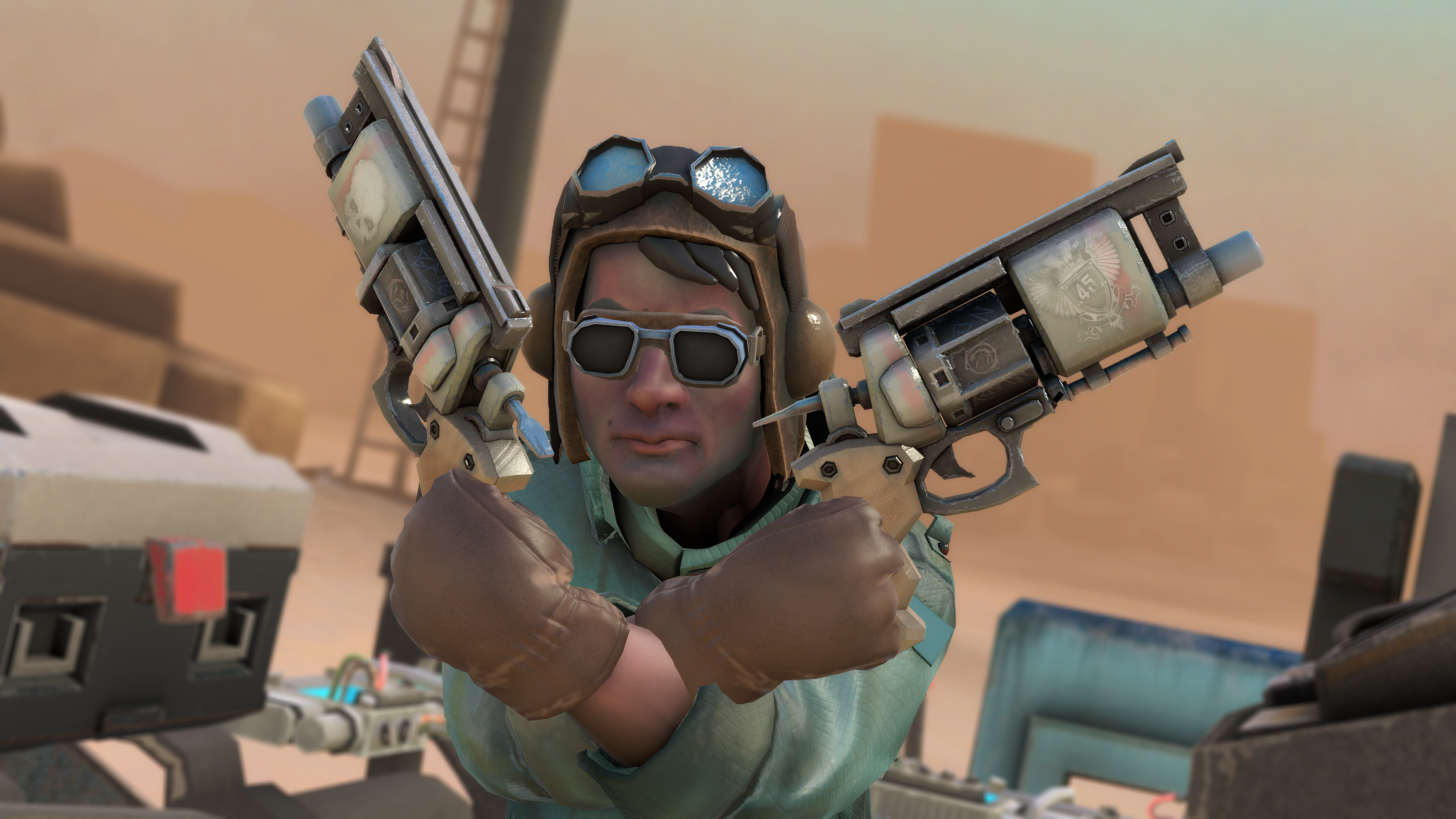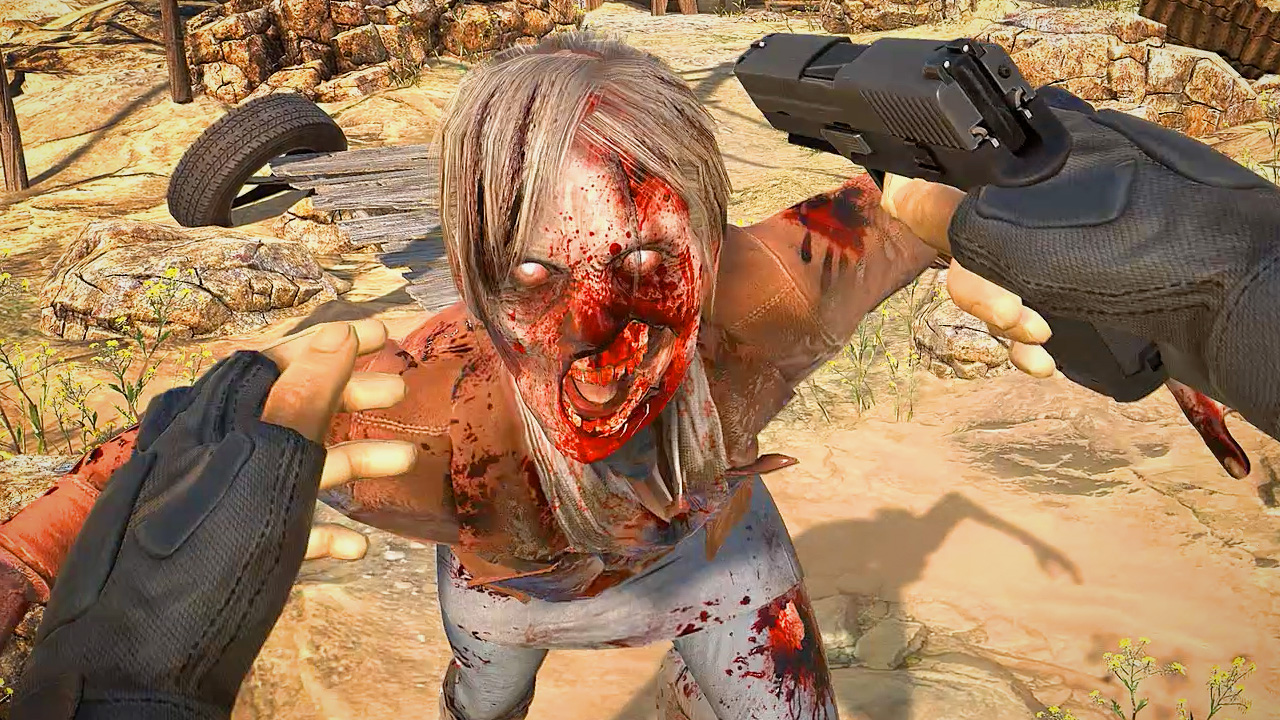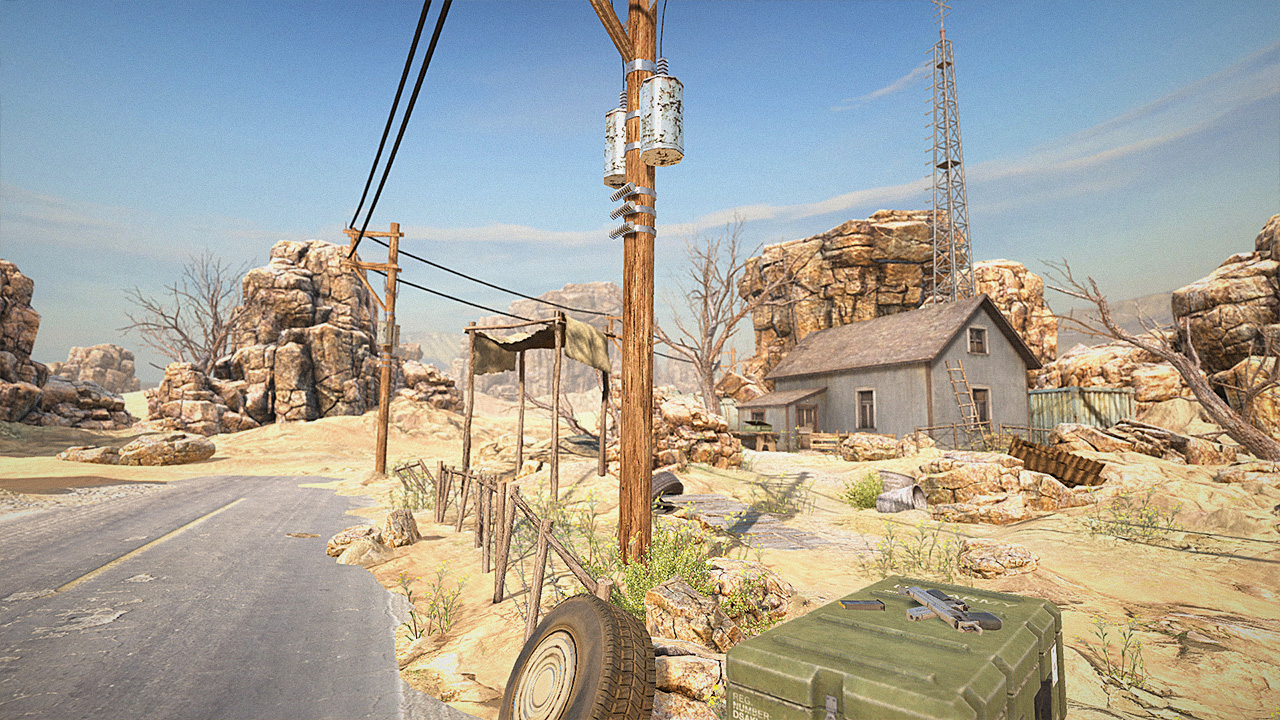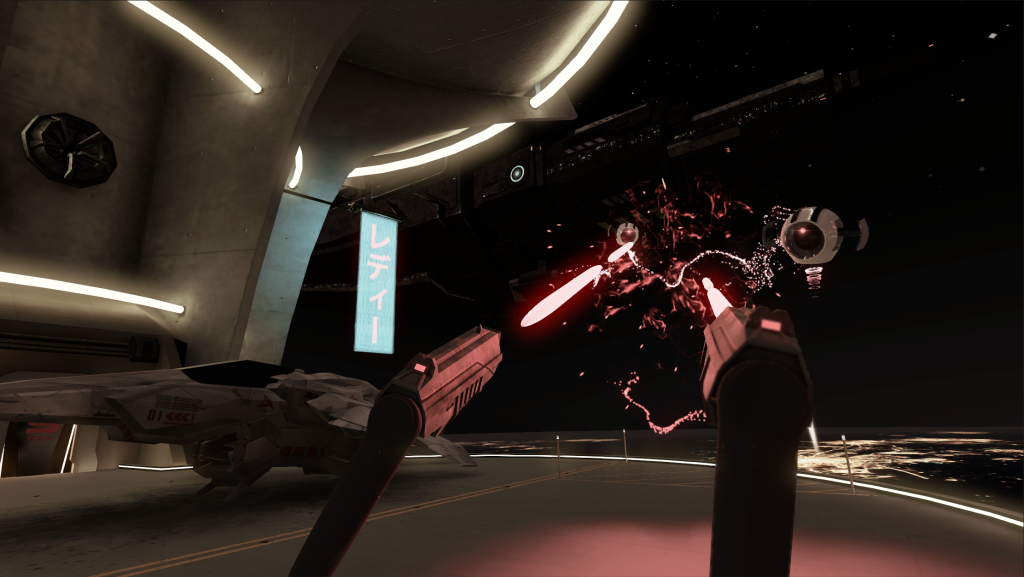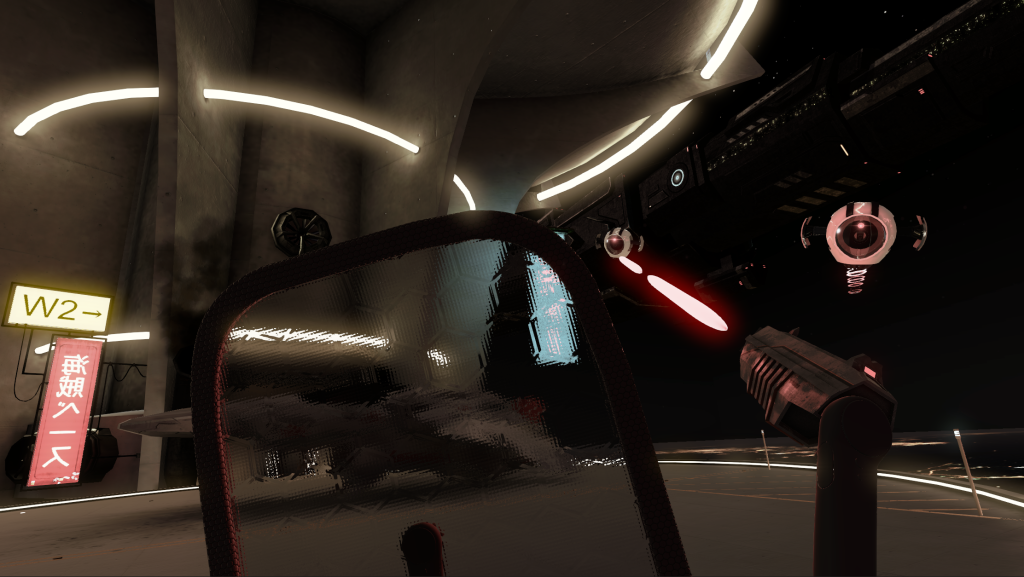VR Devs Approaching FPS Games In Very Different Ways
When people first hear about virtual reality, they start to consider what they might want to do in VR. Playing a first person shooter often comes to mind. At first thought, games like Call of Duty or Crysis may seem like they would be amazing in VR, but making it work is a whole different story. Barring a fancy peripheral such as Virtuix’s Omni, you can’t really walk far in VR, which severely limits your ability to play existing FPS titles with a VR HMD.
Early solutions included using game controllers or keyboard-and-mouse setups to use the traditional control schemes, but that approach made too many people sick, so most developers have scrapped the idea of linear movements done with a controller for VR games.
Shooter games for virtual reality require a different approach altogether. Even with a system like HTC’s Vive, where you can walk around your room and be tracked within the game, you are limited to a small confined space. Games designed for this kind of setup need to be adapted for this limitation.
Fortunately for FPS fans, there are a number of developers working on ways to make compelling games within these constraints. I had the chance to try out three different shooters during Steam VR’s Developer Showcase this week, and each one had a very different way to solve the problem.
Make Your Play Area Movable
Stress Level Zero’s Hover Junkers was the first of the three FPS games that I had a chance to preview. The game solves the long distance travel issue by placing you on a hovercraft that you can move around as you need. The surface of the craft never changes orientation, so you never see the game world rotate (which can be very off-putting when that movement comes from an external source.) However, you can still move around freely on the surface of your craft.
A big part of the game is the cover system. Each ship lets you add a certain number of scrap pieces to its sides that act as cover. You can duck behind these barricades to avoid getting shot. There’s no button to press when you want cover, either -- you really do have to physically duck down or crouch. Hover Junkers is definitely an active game.
For the demo, I was shown only one ship, but Brandon Laatsch, Founder of Stress Level Zero, told me that there will be 17 different crafts to choose from when the game ships in April with the Vive launch. The hovercraft options are more about room size than anything else. The company had to account for all the different room setups that potential players might have to at home. The game requires movement and room-scale tracking, so its solution is to provide a ship for every size.
Get Tom's Hardware's best news and in-depth reviews, straight to your inbox.
Hover Junkers includes two different guns, a revolver and a single-handed triple-barrel shotgun. Laatsch told me the game is staying away from two-handed weapons because they don’t feel natural when using two separate controllers, but the company is experimenting with a couple other weapon choices, including grenades.
Look To The Past
Stress Level Zero took on the problem with a modern solution, but there are other ways to get around it. Vertigo Games looked at arcade games from decades ago and took inspiration from them to manage travel with Arizona Sunshine, its upcoming VR zombie game. Several showcase attendees remarked that the game reminded them of the House of the Dead Arcade game from the mid-1990s.
Arizona Sunshine is broken into small zones that you take on one at a time. Rather than running away when things get crazy, you have to actually clear the area before you can move to the next zone. In each section you basically stand your ground and defend your position. You rarely feel like you have to move at all -- the zombies will come to you -- and if your aim is decent, you probably won’t have much to worry about.
Once the stage is clear, a target will appear in the air. Shoot the target, and you will be transported to its location, where you will likely find a pile of ammo clips, and sometimes a new weapon or item. The process feels very similar to the old on-rails shooters from the arcade games, but instead of the camera moving forward in an animation, the new area just loads into view, which avoids any potential nausea-inducing animations.
The demo of Arizona Sunshine that was playable at the showcase was a simple linear path mission, but John Coleman, Director of Business Development for Vertigo Games, told me that in the final game, story mode will have multiple branches you can follow; it won’t just be linear. There will also be a co-operative multiplayer story mode, and a co-op mode where you simply defend your ground together from wave after wave of zombies. He also noted that there will be roughly 25 guns in the final game.
Coleman said that Arizona Sunshine will not be making the launch window. Instead, the company is targeting a September/October launch for this title.
And Even Further To The Past
I-Illusions’ founder, Dirk Van Welden, took inspiration from a little further back than the '90s for his company’s game, Space Pirate Trainer. Welden compared his game to Asteroids from the 1970s, but I feel like there’s some Space Invaders in there, too.
In Space Pirate Trainer, you are tasked with defending a spaceship that is parked on a space station from incoming drones that are trying to destroy it. They come in from above, below and around 180 degrees or so in front of you.
You are on foot, armed with two laser pistols that can be switched for rail guns or shields, in any combination of two. You have to shoot the droids out of the sky before they hit you with their own laser weapons. To avoid getting shot, you have to move around, dodging incoming laser beams, and manage incoming enemies from different directions at once.
I-Illusions has managed to create a very fun (this was definitely my favorite game at the showcase) shooter experience, while removing the traveling element altogether, and it works really well. It puts more emphasis on using the available space for roomscale VR, and completely eliminates the “How do I get from here to there?” problem.
The company has been working in VR for only four months, and only submitted the first alpha of Space Pirate Trainer to Valve in December. If the fact that the game is already being showcased at the Steam VR Developer Showcase doesn't give you an idea how well it plays, consider that it was the talk of the group at the event, and likely the most popular choice for favorite experience.
Just Figuring It all Out
After spending some time playing all three of these games (and a little bit of Epic’s Bullet Train with Oculus Touch at CES), it’s clear to me that there is much potential for some great VR FPS experiences. Developers are still just figuring out how to approach many of the problems that these new games are presenting, and it’s clear there isn’t just one solution at this point in time. Each of these games managed their own way of getting past the same limitation, and they all succeeded at minimizing the issue of traveling around.
None of these are be-all-end-all solutions, but we don’t need full-range movement to have a compelling game. First generation VR titles will have their teething pains, but there are already a few solid entries into the shooter genre to look forward to this year.
Follow Kevin Carbotte @pumcypuhoy. Follow us on Facebook, Google+, RSS, Twitter and YouTube
Kevin Carbotte is a contributing writer for Tom's Hardware who primarily covers VR and AR hardware. He has been writing for us for more than four years.
-
kcarbotte Reply17422137 said:I have no problem with a vr fps where you can move around like any other game
You may be the exception, but that is certainly not the case for most people. That kind of locomotion was quickly found to be very unsettling for most people.
https://www.youtube.com/watch?v=FGVrvBszHhc&ab_channel=BrandonJLa
-
irish_adam Surely then the solution is head tracking and a game pad where you only use one analog stick to move forward, back and strafe while head tracking lets you look around, you could have it so if your head moves past a certain point it also moves your character round.Reply
Because actually moving around all the time seems a bit shit and will mean you only use your vr headset for vr only games and who's going to be making awesome high budget games for such a small amount of users? even if you did get big budget games you'll always be stuck in your little movable box and no matter how you come up with tricks, you'll never get the real free to roam games and maps we get these days -
zambutu Reply17422222 said:17422137 said:I have no problem with a vr fps where you can move around like any other game
You may be the exception, but that is certainly not the case for most people. That kind of locomotion was quickly found to be very unsettling for most people.
https://www.youtube.com/watch?v=FGVrvBszHhc&ab_channel=BrandonJLa
that would be disappointing as the whole point of 90fps and low persistence is to minimise simulator sickness. I played hl2 and both episodes through on dk1 and half way on dk2. I had no issues, but I can see how others would. However, I don't understand why cv1 cant solve the motion issues for most others, unless running around in vr while standing still in real life is psychologically disturbing.
hover junkers creates a 1:1 movement experience, but fast motion is fast motion...its still there
-
zambutu Reply17422305 said:Surely then the solution is head tracking and a game pad where you only use one analog stick to move forward, back and strafe while head tracking lets you look around, you could have it so if your head moves past a certain point it also moves your character round.
Because actually moving around all the time seems a bit shit and will mean you only use your vr headset for vr only games and who's going to be making awesome high budget games for such a small amount of users? even if you did get big budget games you'll always be stuck in your little movable box and no matter how you come up with tricks, you'll never get the real free to roam games and maps we get these days
17422307 said:17422222 said:17422137 said:I have no problem with a vr fps where you can move around like any other game
You may be the exception, but that is certainly not the case for most people. That kind of locomotion was quickly found to be very unsettling for most people.
https://www.youtube.com/watch?v=FGVrvBszHhc&ab_channel=BrandonJLa
that would be disappointing as the whole point of 90fps and low persistence is to minimise simulator sickness. I played hl2 and both episodes through on dk1 and half way on dk2. I had no issues, but I can see how others would. However, I don't understand why cv1 cant solve the motion issues for most others, unless running around in vr while standing still in real life is psychologically disturbing.
hover junkers creates a 1:1 movement experience, but fast motion is fast motion...its still there
sounds fine to me, question is, do the vive controllers have a game pad like movement ability? or are they for object manipulation only -
kcarbotte Reply17422305 said:Surely then the solution is head tracking and a game pad where you only use one analog stick to move forward, back and strafe while head tracking lets you look around, you could have it so if your head moves past a certain point it also moves your character round.
Because actually moving around all the time seems a bit shit and will mean you only use your vr headset for vr only games and who's going to be making awesome high budget games for such a small amount of users? even if you did get big budget games you'll always be stuck in your little movable box and no matter how you come up with tricks, you'll never get the real free to roam games and maps we get these days
You're right, you won't get the free roam high-budget games, at least not for a while.
If you wan't a controller that moves you around, look to Oculus Rift, but you likely won't see any FPS games using that setup.
Certain game will work great with a game pad, others will need hand tracking, Vive games will often use a space you move around in.
VR games aren't going to replace standard games in the short term. They will mostly be very different experiences, developed solely for VR.
-
zambutu Reply17422412 said:17422305 said:Surely then the solution is head tracking and a game pad where you only use one analog stick to move forward, back and strafe while head tracking lets you look around, you could have it so if your head moves past a certain point it also moves your character round.
Because actually moving around all the time seems a bit shit and will mean you only use your vr headset for vr only games and who's going to be making awesome high budget games for such a small amount of users? even if you did get big budget games you'll always be stuck in your little movable box and no matter how you come up with tricks, you'll never get the real free to roam games and maps we get these days
You're right, you won't get the free roam high-budget games, at least not for a while.
If you wan't a controller that moves you around, look to Oculus Rift, but you likely won't see any FPS games using that setup.
Certain game will work great with a game pad, others will need hand tracking, Vive games will often use a space you move around in.
VR games aren't going to replace standard games in the short term. They will mostly be very different experiences, developed solely for VR.
This makes me happy to sit and wait for the vr dust to settle before investing in one of these systems. the DK2 will be supported by many developers for at least a while.
I just feel that a 1440p version of dk2 released last year as a cv1 (for 400$) would have been the perfect transition into the high end kits they're bring out this year. Get the headset into more hands for the price, hard working developers could be selling their games already and Oculus could take their time perfecting their premium unit and releasing the touch controllers at the same time as "cv2."
I dunno, maybe wasn't feasible, but feels like a missed opportunity to me. -
LuxZg +1 for waiting for the dust to settle. Still too many ifs and whats, still too much $$$ and too little content, still a huge fragmentation of hardware vs content, etc.Reply
Let them figure it all out and than we can buy into this, let early adopters iron it out :p
As for the FPS, to have the freedom, gameplay and storyline of todays first person games (be it shooters, adventures or role playing games) in VR - we'll need to wait a long while. Otherwise you have gameplay regression just to have it in VR. It would be like using VR to read a book, and than having to suffer through bad ones after you "got used to" (or got spoiled) by the masterpieces of the past. Simply... Needs refining before much $$$ is spent by masses. -
Durandul ReplySurely then the solution is head tracking and a game pad where you only use one analog stick to move forward, back and strafe while head tracking lets you look around, you could have it so if your head moves past a certain point it also moves your character round.
Because actually moving around all the time seems a bit shit and will mean you only use your vr headset for vr only games and who's going to be making awesome high budget games for such a small amount of users? even if you did get big budget games you'll always be stuck in your little movable box and no matter how you come up with tricks, you'll never get the real free to roam games and maps we get these days
With my DK1, the games that did that were worse actually even worse. Having keyholing in VR made me almost instantly sick while playing Half-Life 2. That was the only time I actually got a headache using the Rift.
I think we'll see a few solutions emerge, but I'm guessing something like Arma's solution with TrackIR will catch on for games that stick with a more traditional FPS format. -
thor220 Man, if only we knew how to intercept nerve signals and covert them into digital data. That'd really solve so many issues.Reply
